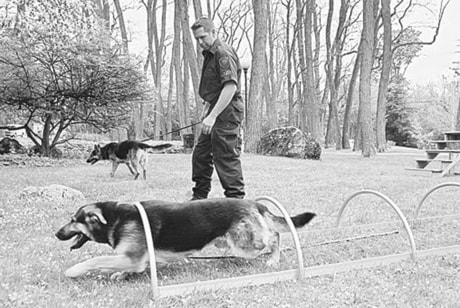LOS ANGELES — One hundred sheriff’s deputies and 400 part-time deputies were laid off. SWAT officers were ordered back to the streets. Narcotics and gang units were disbanded. Helicopters were grounded.
K-9 survived.
To absorb more than $30 million in losses, the Sacramento County Sheriff’s Department had to focus almost exclusively on answering 911 calls, but police dogs and their handlers survived the cuts. It’s a scenario that is playing out among the thousands of K-9 teams across the United States that have survived deep budget cuts to stay on the job.
In part that’s because dogs are winning the popularity contest. In a few towns where K-9 dogs were cut, citizens rallied to raise money to keep the animals at work. They’ve even had help from celebrity friends like Ozzy Osbourne, who donated a K-9 dog to the Muncie, Ind., Police Department in September.
But there are other advantages to keeping animals on the job. They protect the officers they work with, do jobs that people can’t and use bites, not bullets.
“When you look at the tremendous savings in man-hours that are achieved by using trained dogs to search for suspects or victims or narcotics or explosives, it’s very easy to recognize the fact that they are probably the most cost-efficient tool we have,” said officer Bill Cassell of the Las Vegas Metropolitan Police Department.
Dogs can run faster, get into tighter spots and look more menacing than most humans. Plus they have stronger noses, better hearing and better vision, at least under low light conditions.
“They are so valuable, so important to what police officers do,” said Pamela Reid, vice-president of the ASPCA’s Animal Behavior Center in Urbana, Ill.
In San Diego, police eliminated 12 dogs from its K-9 corps to save around $500,000 of the $15 million it had to cut. But the department still has 27 dogs on the force in a city where a use-of-force panel recommended more K-9 units because of the number of people being shot by officers.
That was 20 years ago, and things have changed, said Assistant Chief Bob Kanaski.
“I don’t expect to see a rise in officer-involved shootings,” he said. “We’ll miss the dogs, no doubt about it. We’ll have to use different tactics to slow things down until we get the dogs there.”
Cleveland, Ohio, reduced its K-9 unit in 2004 when the department lost 252 jobs, but the dogs were all reinstated, said Tom Ross, recording secretary for the Cleveland Police Patrolmen’s Association.
To a street officer, the benefits of a dog are immeasurable, Ross said. “If they (suspects) think you’re going to let that dog go, it’s going to influence their decision (to run or surrender),” Ross said.
No K-9 in the country has more job security right now than Nitro, the lone K-9 at the Aberdeen, Wash., Police Department. Nitro was laid off in May as police struggled to wring every last cent from a shrivelling budget, Chief Robert Torgerson said.
But the German shepherd was back two months later because the department received $14,000 in donations from around the country and a $43,000 cheque from the philanthropic Tamaki Foundation in Seattle. That was enough to buy a new dog vest, the department a new K-9 car and guarantee Nitro four more years on the job, Torgerson said.
“It was great. We were blessed,” Torgerson said.
The Bloomsburg, Pa., Police Department laid off their three dogs one year ago, Chief Leo Sokoloski said, when town fathers chose to eliminate them instead of the department’s 26 sworn and civilian personnel. It saved $5,000 to $6,000, the chief said.
A lot of people heard about it and sent money. Several thousand dollars came in.
“But in the interest of fairness to the good will of the people, we sent the money back with gratitude. The council’s decision was not to reimplement the program,” Sokoloski said. “We decided it was prudent to wait and see if the economy gets better.”
A K-9 dog costs between $10,000 and $20,000, and must be trained along with its handler, said Sacramento Deputy Brian Amos. Even so, dogs are the “cheapest employee that any agency will ever have,” said Russ Hess, director of the United States Police Canine Association.
“He only works for the love and his food,” he said.
Every department in the country is cutting everything they can, said Jeff Meyer, the publisher of Police K-9 Magazine in Lakewood, Colo., but you don’t see the public support for other programs the way you do the dogs. Pittsburgh Steelers’ quarterback Ben Roethlisberger’s foundation has donated money to that city’s police department for K-9s and equipment. He also donates a dog to all the cities where the Steelers play each year.
The 22 K-9 teams with the St. Paul, Minn., Police Department became mini celebrities when their unit was featured in an Animal Planet series.
“It was one of the first opportunities for people to see what police dogs do, not only here, but across the country, every day,” Sgt. Paul Dunum said.
Dunum said he is constantly amazed by what the dogs do. One of the best things is winning over people. Money, Dunum said, can’t buy that kind of good will.
